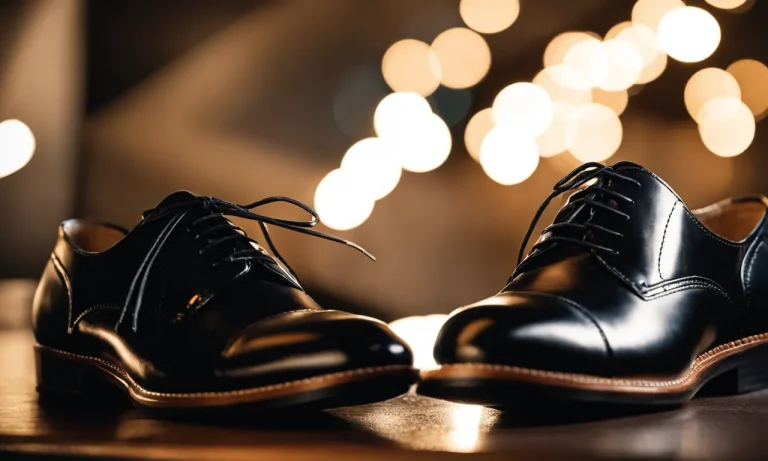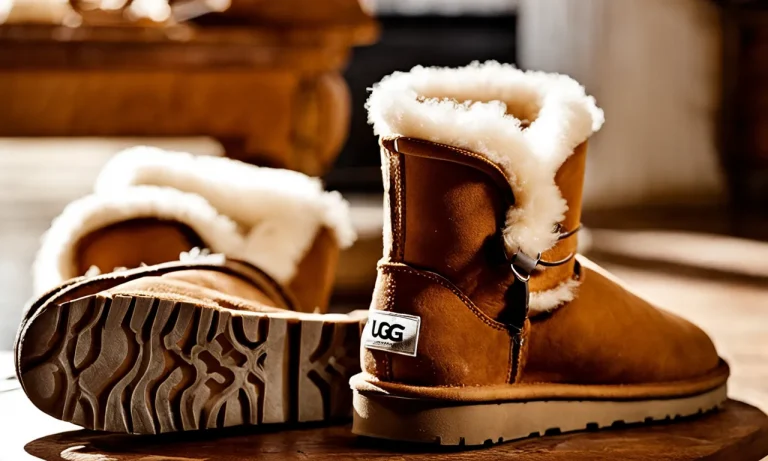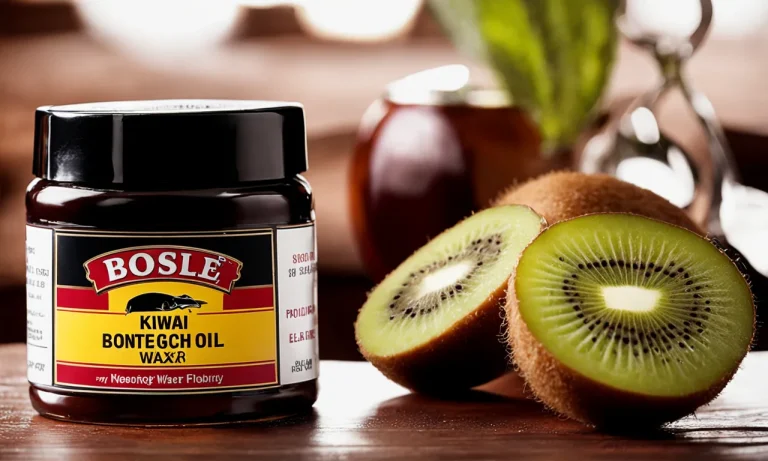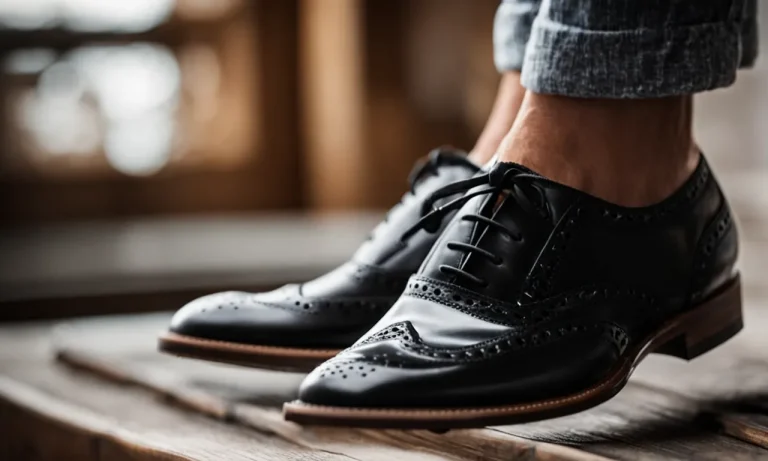If you just bought a new pair of boots, you’re probably wondering how long it will take before they feel like a second skin on your feet. Breaking in boots is essential to stretch the materials and mold the shape to your feet for maximum comfort, but it does require some patience.
If you’re short on time, here’s a quick answer to your question: breaking in most leather boots takes around 5-20 wears over 2-4 weeks for the upper, sole, and insole to fully adjust to your feet. Certain factors like leather type, fit, and your break-in habits impact the timeline.
In this comprehensive guide, we’ll cover everything you need to know about the boot break-in process. You’ll learn the key factors that determine break-in timelines, the stages boots go through as they conform to your feet, tricks to speed it up, and how to tell when your boots are finally broken in.
Typical Break-In Timelines for Different Boot Materials
Leather Boots: 2-4 weeks of moderate wearing
When it comes to leather boots, patience is key. Leather is a durable material that requires time to mold and shape to your feet. On average, it takes about 2-4 weeks of moderate wearing to break in leather boots.
During this time, it’s important to wear them for a few hours each day, gradually increasing the duration as your feet become more accustomed to the boots. Don’t be discouraged if they feel tight or uncomfortable at first – leather has a natural ability to stretch and conform to your feet over time.
To speed up the break-in process, you can use leather conditioner or boot stretching techniques recommended by reputable shoe experts.
Suede Boots: 1-2 weeks with extra care
Suede boots, although made from the same material as leather boots, have a slightly different break-in timeline. Due to the delicate nature of suede, it requires extra care during the initial wearing period. Suede boots typically take about 1-2 weeks to break in.
To ensure a smooth break-in process, it’s important to protect them from moisture and avoid excessive friction. Use a suede protector spray before wearing them for the first time to guard against stains and water damage.
Additionally, brushing them regularly with a suede brush will help maintain their softness and restore the nap of the suede.
Rubber Boots: 1-5 wears as rubber softens
Rubber boots, such as those used for gardening or rainy days, have a much shorter break-in period compared to leather or suede boots. This is because rubber is a flexible material that naturally softens with use. On average, it takes about 1-5 wears to break in rubber boots.
During this time, the rubber will gradually mold to the shape of your feet, providing a more comfortable fit. It’s important to note that some individuals may find rubber boots comfortable right out of the box, while others may require a few wears for optimal comfort.
To maintain the longevity of your rubber boots, it’s recommended to clean them after each use and store them in a cool, dry place.
What Happens During the Break-In Process
Breaking in a new pair of boots can be an uncomfortable process, but it is necessary to ensure a perfect fit and maximum comfort in the long run. During the break-in process, several changes occur in the boots that allow them to conform to the shape of your feet.
Understanding these changes can help you navigate through the initial discomfort and enjoy your boots for years to come.
Upper stretches for fit
One of the main things that happen during the break-in process is that the upper part of the boots stretches to accommodate the shape of your feet. This is particularly important if you have wider or narrower feet.
The leather or synthetic material used in the upper part of the boots gradually loosens up, allowing your feet to move more freely and reducing the feeling of tightness. However, it’s important to note that this stretching process may take some time, so it’s best to be patient and not force the boots to fit.
Insole molds to foot shape
Another important change that occurs during the break-in process is that the insole of the boots starts to mold to the shape of your feet. The insole is the cushioned part of the boot that provides support and comfort.
As you wear the boots, the insole compresses and adjusts to the contours of your feet, creating a customized fit. This not only enhances comfort but also improves stability and reduces the risk of blisters or pressure points.
Outsole gains flexibility
During the break-in process, the outsole of the boots also gains flexibility. The outsole is the bottom part of the boot that comes into contact with the ground. Initially, it may feel stiff and rigid, but with regular wear, it becomes more supple and allows for a natural walking motion.
The increased flexibility of the outsole improves traction, making it easier to walk on different surfaces without slipping.
It’s important to note that the break-in process can vary depending on the type of boots and the materials used. Some boots may require a longer break-in period than others. It’s always a good idea to refer to the manufacturer’s recommendations or seek advice from experts in shoe fitting.
For more information on how to break in boots properly, you can visit websites like REI or Boot Mood Foot. These resources provide valuable tips and advice on how to make the break-in process more comfortable and effective.
Factors That Impact Break-In Time
Leather quality and thickness
The quality and thickness of the leather used in boots play a significant role in determining the break-in time. High-quality, supple leather tends to be more comfortable and molds to the shape of your feet faster, reducing the break-in period.
On the other hand, boots made with thicker and stiffer leather may require more time and effort to break in.
According to bootratings.com, boots made from full-grain leather, which is the highest quality, typically break in quicker compared to boots made from lower-quality leather.
Construction method
The construction method used in making the boots can also affect the break-in time. Different construction methods, such as cementing, welted, or stitch-down, impact the flexibility and overall comfort of the boot.
Generally, boots constructed using the welted or stitch-down methods require a longer break-in period as they are initially stiffer. Cemented boots, on the other hand, tend to have a shorter break-in time due to their more flexible construction.
Bootratings.com suggests that welted or stitch-down construction methods provide better durability and support, making the longer break-in time a worthwhile trade-off for many boot enthusiasts.
Fit – snug but not too tight
The fit of your boots is essential for both comfort and break-in time. Boots that are too tight can cause discomfort and blisters, while boots that are too loose may not mold to your feet properly. The ideal fit is snug but not overly tight.
It’s important to note that different brands and styles of boots may have slightly different sizing, so it’s always recommended to try them on before making a purchase. Additionally, wearing the right socks can also impact the fit and break-in time.
Your break-in regimen
Your break-in regimen, including how often and how long you wear the boots, can also influence the break-in time. Gradually increasing the duration of wear can help your feet adjust to the boots more comfortably.
It is generally recommended to wear the boots for short periods initially and gradually increase the duration as your feet get accustomed to them.
Applying a leather conditioner or boot oil can also help soften the leather and speed up the break-in process. However, it’s important to follow the manufacturer’s guidelines and not over-condition the boots, as it can lead to leather damage.
Tips to Speed Up the Break-In Process
Breaking in new boots can be a frustrating and uncomfortable experience. However, there are several tips and techniques you can use to speed up the process and make it more bearable. Here are some effective ways to break in your boots faster:
Use a boot stretcher
One of the quickest ways to break in your boots is by using a boot stretcher. This handy tool can help stretch the tight areas of your boots, providing more room for your feet to move comfortably. Simply insert the stretcher into your boots, adjust it to the desired width, and leave it overnight.
You’ll be amazed at how much of a difference it can make!
Apply leather conditioner
Leather boots can be stiff and uncomfortable when they’re brand new. To soften them up, apply a high-quality leather conditioner. This will moisturize the leather and make it more pliable, allowing the boots to mold to the shape of your feet more easily.
Be sure to follow the manufacturer’s instructions for the best results.
Wear thick socks
Thick socks can provide extra cushioning and help protect your feet from any potential blisters during the break-in process. Additionally, wearing thick socks can create more friction between your feet and the boots, which can help stretch the leather more quickly.
Consider wearing them while you’re breaking in your new boots, and you’ll notice a difference in comfort.
Walk on various surfaces
Walking on different surfaces can help speed up the break-in process by flexing and bending the boots in different ways. Take your boots for a spin on different terrains, such as gravel, grass, or pavement. This will help the leather loosen up and conform to your feet more naturally.
Use a cobbler for stretching
If you’re struggling to break in your boots on your own, consider taking them to a professional cobbler. Cobblers have specialized tools and techniques to stretch boots effectively. They can also provide advice on the best ways to care for and maintain your boots.
By following these tips, you can significantly reduce the break-in time for your new boots. Remember, patience is key, and it’s important to listen to your feet. If you experience any pain or discomfort, take a break and give your feet some rest.
With a little time and effort, you’ll have a comfortable and well-fitted pair of boots that will last for years to come.
How to Know When Your Boots Are Fully Broken In
Breaking in a new pair of boots can be a daunting task, but once they are fully broken in, they can provide you with years of comfort and durability. However, it can be difficult to determine when your boots are truly broken in and ready to be worn for extended periods of time.
Here are a few key signs to look out for:
Snug but comfortable fit
One of the first signs that your boots are fully broken in is when they have a snug but comfortable fit. Initially, new boots may feel tight or stiff, but as you wear them, the leather or synthetic material will begin to mold to the shape of your foot.
Pay attention to any areas that feel too tight or too loose. Your boots should feel secure on your feet, but not so tight that they cause discomfort or restrict movement.
No blisters or hotspots
An important indicator that your boots are fully broken in is the absence of blisters or hotspots. When boots are new, they can rub against your skin and cause painful blisters. However, as the material softens and conforms to your foot, the likelihood of developing blisters decreases.
If you have worn your boots for a considerable amount of time without experiencing any discomfort or blisters, it is a good sign that they are broken in.
Upper moves naturally
Another way to determine if your boots are fully broken in is by observing how the upper part of the boot moves when you walk. Initially, new boots may feel stiff and restrict your foot’s natural movement.
However, as you wear them, the leather or synthetic material will become more flexible, allowing for a natural range of motion. If you notice that your boots no longer feel stiff and your foot can move freely, it is a clear indication that they are broken in.
Insole matches foot shape
The final sign that your boots are fully broken in is when the insole matches the shape of your foot. When boots are new, the insole may feel flat or rigid, but as you wear them, it will gradually contour to the unique curves and arches of your foot.
This provides you with customized support and comfort. If you can feel that the insole has molded to the shape of your foot, you can be confident that your boots are fully broken in.
Remember, breaking in boots is a process that can vary depending on the type of boot and individual preferences. It is important to be patient and give your boots enough time to adapt to your feet. If you are experiencing persistent discomfort or issues with your boots, it is always a good idea to consult a professional or a reputable website like OutdoorGearLab for further guidance.
Conclusion
Breaking in boots properly is crucial for comfort and longevity. While it does require some patience upfront, the payoff is well worth it. Invest the time to let your footwear mold to your feet, and you’ll be rewarded with years of customized comfort and support.
With the tips above, you can confidently break in your next pair of boots for a perfect fit.






